
Sewer Workers
As Sonu Bahot, 36, emerges from a sewer in New Delhi, India, passersby often cover their noses from the stench and fumes that can be overwhelming. Described as the worst job on earth, Bahot has been doing this consistently for over 16 years to support his family. By birth he and his colleagues are members of the Valmiki community, the bottom wrung of the social hierarchy in India dating back thousands of years, a subcategory of “untouchable” Dalits. Because of discrimination and lack of opportunities, they work one of the dirtiest and most dangerous jobs in the subcontinent, if not the world.
Photograph © Renée C. Byer

Kusum Pahari Slum
Three of five boys from the family of Dona Devi, 35, and her husband Kamal Singh, 50, play on a bed that occupies their entire living space in the Kusum Pahari slum in South Delhi, India. From left are Ajit Kumar, 5, Dilip Kumar, 9, background and Kuldeep Kumar, 10, foreground. Kusum Pahari slum in south Delhi (opposite Hotel Inter continental) is located on a garbage dump where meat butchers also graze their pigs. The pigs freely roam the neighborhood. There has been a government order to abolish the slum but the people that have been living there for almost 25 years have no where to go.
Photograph © Renée C. Byer

Children Helping Children
Also true among the poor is the fact that children everywhere take care of other children. Here Vishal Singh, 6, cares for a baby girl while her mother is away in the Kusum Pahari slum in south Delhi, India. When Vishal is not working or attending to his chores, he attends a school for the children of the Kusum Pahari slum. It is located on the slum grounds. The school is an open-air facility. It has no power, no toilets and no books. To learn their lessons the children and teachers here work off chalkboards. Tuition is 2 rupees a week but no child is turned away for lack of funds. When Vishal is not working, he goes off to school with nearly 600 other children of this slum community.
Photograph © Renée C. Byer

Fetching Water
Sharda Devi, 30, returns home to collect water for her family of six after working all day as a manual laborer at a construction site making 150 Indian Rupees, the equivalent of $2.23. Behind Sharda is the Charan Slum Settlement in Dharamsala, India where she lives in a tent-like structure with no electricity, running water or bathroom. She will return to cook dinner over a small fire. One of her children suffers from epilepsy and the family can’t afford much more as they struggle to pay for his medicine.
Photograph © Renée C. Byer

Hope For Charan
Starvation
In the Charan slum settlement of northern India, Kalpana, 20, starves one of her children Sangeeta, 2, while her sister Sarita, 5-months-old, right, sleeps in comfort, above right, in her mother's arms. Sangeeta only weighs 9 pounds. Children are more likely to appeal to the sympathy of those inclined to give to beggars, so those who beg use children for this purpose. Worse, sometimes as in this case a child is starved and carried about by the child's parent while she begs on the streets or rented out to another beggar to be used as an object of sympathy in the hope of generating more income over the course of a given day. Sometimes these extra funds are used to feed other children, thus, in practice; one child is sacrificed for he sake of others. Sangeeta has since been helped by the Tong-Len Charitable Trust's mobile medical clinic at the Charan slum settlement, Dharamsala, India. But according to the World Bank 19,000 children under the age of five die a day from preventable causes.
Photograph © Renée C. Byer

The Plight of the Poor
Like many of the world's poor, Arjun and his family of five live under the cover of a plastic tarp in the Charan slum settlement outside of Dharamsala, India. They earn their money by begging and collecting recyclables. However, they earn very little, for Arjun, the family patriarch, is blind and the mother of his children is largely their sole breadwinner.
Photograph © Renée C. Byer

Searching for Tea
Rudra, 5, and his sister Suhani, 3, search for tea to drink at the Charan slum Settlement in Dharamsala, India, where they live with their family. They survive although two of their siblings recently died of malnutrition.
Photograph © Renée C. Byer

Hopeful Eyes
In Dharamsala, India, Suraj, 10, waits as rice is passed out in a tent school at the Charan Slum Settlement funded by the Tong-Len Charitable Trust. If not for this daily ritual many of the children would go hungry. Tong-Len's primary and nursery tuition tent schools operate every weekday within the Charan slum camp. These provide free accessible education to children who could not otherwise go to school because of lack of money or work and family commitments. Classes are taught by Indian teachers with help from volunteers.
Photograph © Renée C. Byer

Solar Powered Shower
At the Charan slum settlement children enjoy a morning shower, something never afforded to them before, which gives them a clean start to the day and some relief from India’s often debilitating heat. The solar powered shower facility was a gift from the Tong-Len Charitable Trust in Dharamsala, India.
Photograph © Renée C. Byer
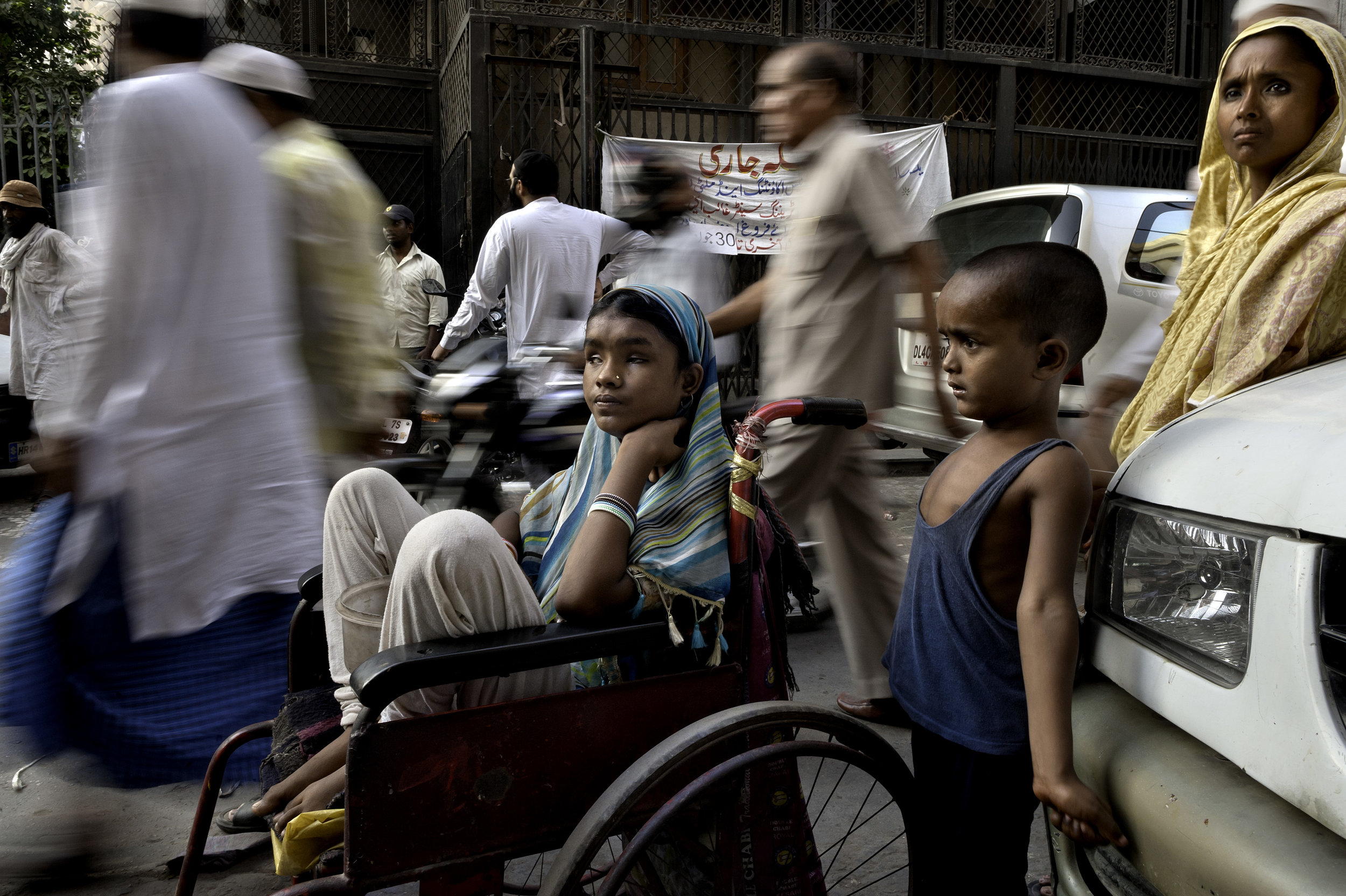
Blind Beggar
A sea of people passes by Hunupa Begum, 13, who has been blind for the past 10 years and lives close to the Nizamudin Bangala Masjid (Mosque) in New Delhi, India. She begs as the only source of income for her family that consist of a brother Hajimudin Sheikh, 6, center, who suffers fluids that accumulate in his head and her mother Manora Begum, 35, right, who suffers from Asthma, and she has a womb ailment and can't do manual labor. Their father Nizam Ali Sheikh died ten years ago of Tuberculosis. Her wheelchair was donated by a passerby.
Photograph © Renée C. Byer

Enough to Eat
In the streets of New Delhi, India, Hunupa Begum, 13, who has been blind for ten years, begs in order to help provide for her mother, left, and younger brother. She begins in the early morning to earn enough for breakfast and then returns at night to earn enough for dinner. She knows no other life.
Photograph © Renée C. Byer

Remain a Family
The Begum family all rely on Hunupa to provide for them. Nevertheless, in every way they can, they all care for each other. Hunupa’s younger brother, Hajimudin Sheikh, 6, suffers from an abnormal level of fluid in his head and her mother, Manora Begum, 35, suffers from asthma as well as a growth in her womb. In spite of
all of this, however, they remain a family.
Photograph © Renée C. Byer

Manora Begum and her family
Manora Begum and her family sleep in intense heat on the streets of New Delhi, India and each night Manora fans her children to sleep outside of a mosque where she believes they will be safe.

Joy Among Deprivation
Blinded for the past ten years Hunupa Begum, 13, and her brother Hajimudin Sheikh, 6, resort to singing and clapping their hands to play and in the process make each other laugh in Delhi, India.
Photograph © Renée C. Byer

Factory Worker, Bangladesh
Parul Begom’s job requires her to feed plastic coated wiring into a machine that releases hazardous fumes as it chops the wire into recyclable pellets, sometimes taking a finger with it. All this she endures in order to come home to a one-room metal enclosure with no heat or electric to care for her children. Begom, 45, is the only woman working at the factory where she severed her thumb six months earlier in Dhaka, Bangladesh.
Photograph © Renée C. Byer

Wedding Day
Arranged marriages are quite common in certain areas of the world. Here a 14-year-old girl in Bangladesh, sitting next to her soon to be husband, was sold off by her family in the hopes that it would bring her a better life. For young girls like her, often it does not.
Photograph © Renée C. Byer

The Cycle Continues
Labone, 27, takes a moment to hold her young daughter Nupur, 1, who was fathered by a client, before she has to return to her evening's work in a brothel in Jessore, Bangladesh. Most children born into the sex trade follow the same cycle of abuse as their mothers. With more than half it's population living below the poverty line, Bangladesh remains one of the poorest countries in the world. As in other countries, poverty, low social status, and lack of opportunities for education and employment have forced women to become sex workers. Many girls are sold by their families into the sex trade for very little money.
Photograph © Renée C. Byer

Hopelessly Waiting
Rozena, 26, waits at the back door of the brothel for clients that wish to remain anonymous. With more than half it's population living below the poverty line, Bangladesh remains one of the poorest countries in the world. As in other countries, poverty, low social status, and lack of opportunities for education and employment have forced women to become sex workers.
Photograph © Renée C. Byer

Covering her Blackened Eye
Brothel worker Pinky prepares for another day’s work using makeup to cover a black eye she received from a client in Jessore, Bangladesh. For many of these women it’s an occupational hazard they endure. At left is an older sex worker she refers to as her mother. The women at the Marwari Mandir brothel keep very little, if any, of the money they earn. Instead, whatever they receive is turned over to their respective “mothers” (these are the madams who often are not related to the sex worker by blood, but instead informally adopt young girls, teach them the trade, and in return provide them with food and shelter for their earnings).
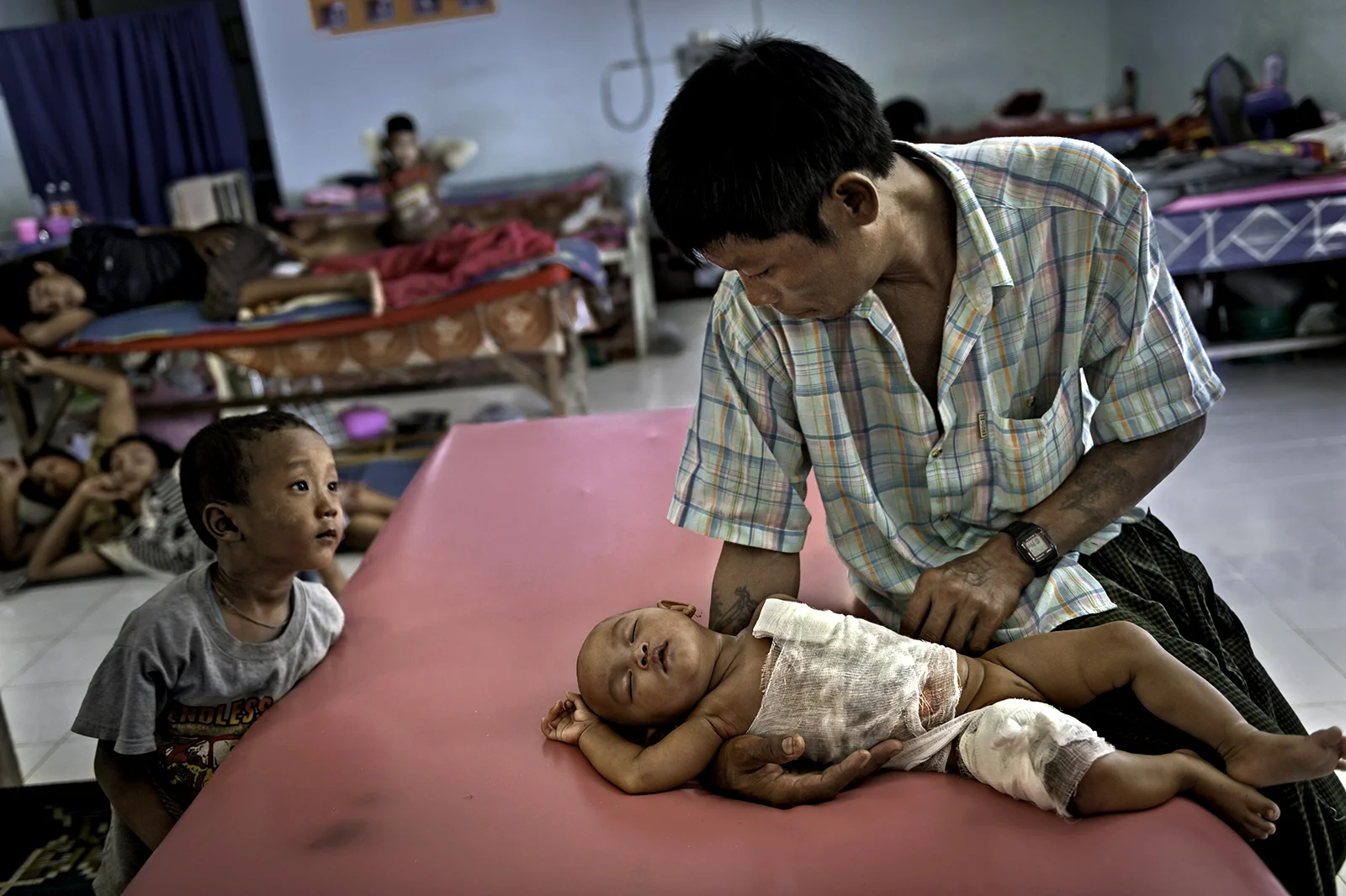
Baby Burn Victim
At the Mae Tao Clinic in Mae Sot, Thailand, this 5-month old baby receives free medical care for her burns, as her father, Zaw Win, and another child anxiously hope for her recovery. The baby had spilled a pot of boiling water on herself while her 11-year old brother was watching her. As Win tends to his daughter, the farmer is losing money and time while away from working on the farm. The clinic was established for Burmese refugees and migrant workers who have little money and no place else to go.
Photograph © Renée C. Byer

Homeless in Bangkok
Pooradej Kaenatip, 18, is one of a group of homeless children sleeping on the streets of Bangkok, Thailand, many of who are addicted to sniffing glue in order to suppress their appetite and in some ways psychologically escape their circumstances. They survive on the streets by nearly any means necessary but are more often victimized by others.
Photograph © Renée C. Byer
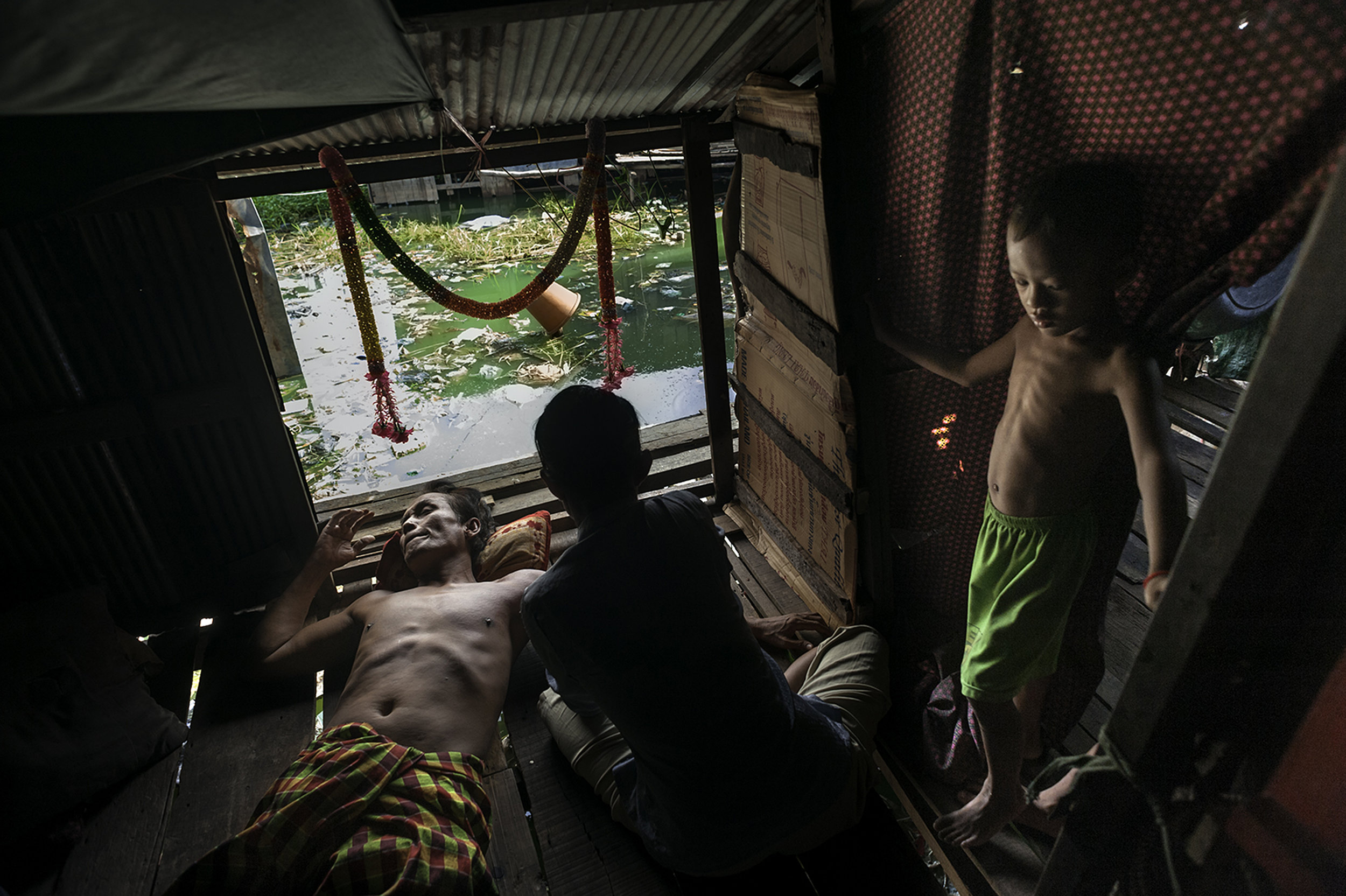
Land Mine Victim Faces Eviction
Phay Phanna, 60, lost his leg when he stepped on a land mine in 1988 near the Cambodian-Thai border. He is a widower and is the sole head of his family, caring for 11 children in a home he does not own. It has been scheduled for demolition since being purchased by a private developer in 2008 in Phnom Penh, Cambodia.
Photograph © Renée C. Byer

Polluted Playground
Outside Phnom Penh Cambodia, Panha Sak, 2, runs alongside the polluted waterways of his home. This area also doubles as his playground. More than 1 billion people lack adequate access to clean drinking water and an estimated 400 million of these are children. Because unclean water yields illness, roughly 443 million school days are missed every year.
Photograph © Renée C. Byer

Bathing in Polluted Water
Docked on the shores of the Mekong and Tonle Sap Rivers, in Phnom Penh, Cambodia, these families carry on all of their daily activities on small boats. At dusk, You Hai Yati, 4, washes herself in these waters. It is the same water that she and her family drink and use to cook every day. She is the youngest daughter of Y You, 50 and Soh Nop, 40. They have seven children. All of them have never gone to school, as their parents could not afford it. They could not read or write at all and only one of them has had a job rather than fishing along with their parents. They have lived there since the fall of Khmer Rouge in 1979. They own no land or house. They own one boat and two-year old fishing net that they keep repairing.
Photograph © Renée C. Byer
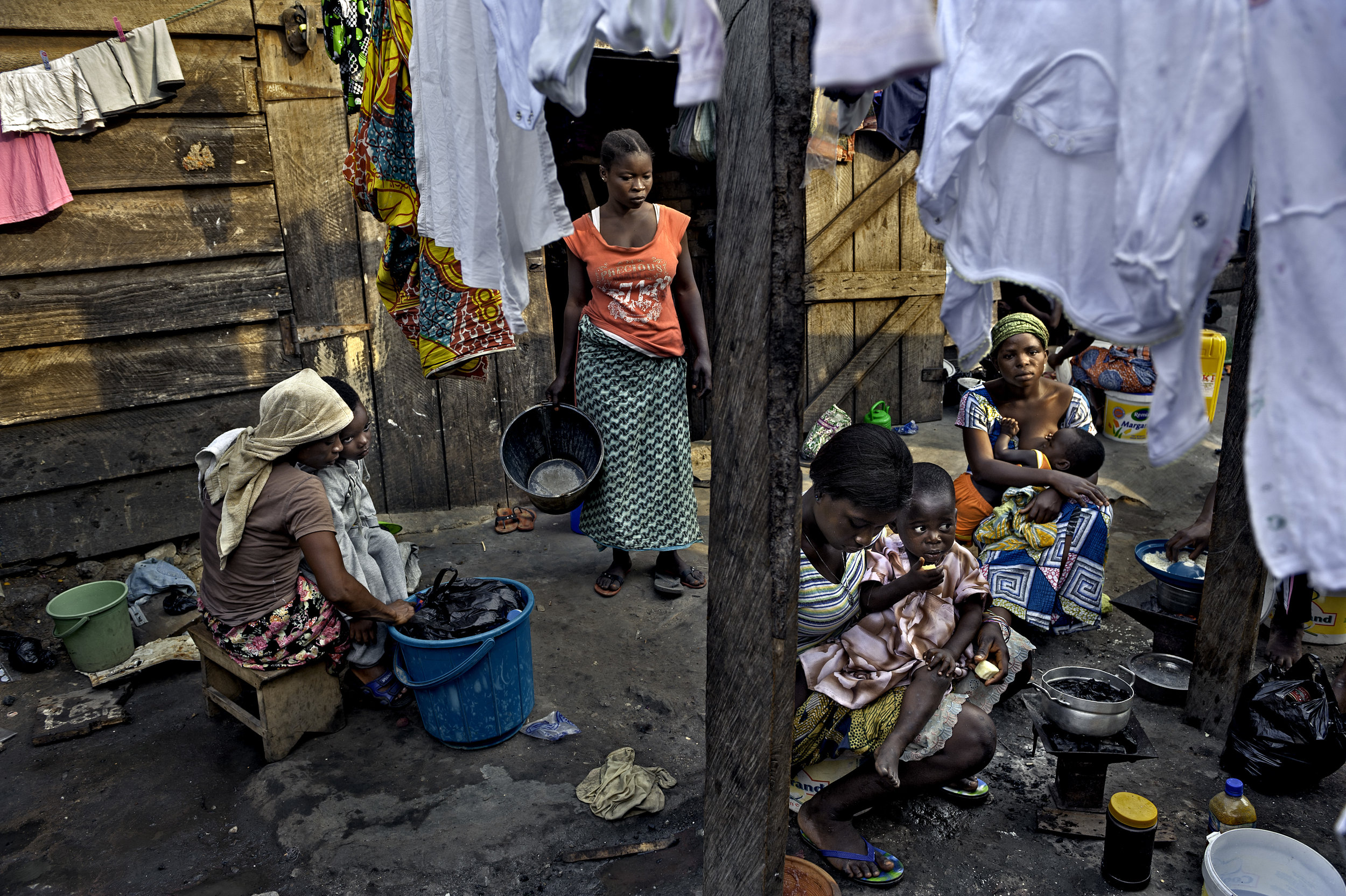
Struggling to Survive
In order to survive, Kayayo Girls live in communal settings that require the least amount of rent, often near or on top of the city dump. Many Kayayo girls known as porters who carry very heavy loads on their heads work with babies strapped to their backs to earn their living. They work Monday through Saturday but on Sunday they tend to daily chores such as laundry, cooking and cleaning in a suburb of Accra, Ghana. "Everyone is struggling so we can't help each other," said Sharifa Montaro, 23, center. These girls come from the North hoping for a better life in the city and find themselves victimized, pregnant with no money to return.
Photograph © Renée C. Byer

A Mother's Love
Kandi, 25, feeds her son Baba, 4, who suffers from malaria. Between her life of work and her son’s need for care, she has little time for herself, but nothing is more clear here than a mother’s love. "No government or NGO's help me. I have to do everything myself. If I could get someone to help me then maybe my life could change," she said. She had come from farmland in the north looking for a better life in the city of Accra, Ghana to find herself exploited and working as a porter carrying heavy loads of fruits and vegetables on her head for sometimes a dollar a day.
Photograph © Renée C. Byer

Working to Survive
In an e-waste dump that kills nearly everything that it touches in Ghana, West Africa, Fati, 8, works with other children searching through hazardous waste in hopes of finding whatever she can to exchange for pennies in order to survive. While balancing a bucket on her head with the little metal she has found, tears stream down her face as the result of the pain that comes with the malaria she contracted some years ago. This is work she must do to survive. Photograph © Renée C. Byer
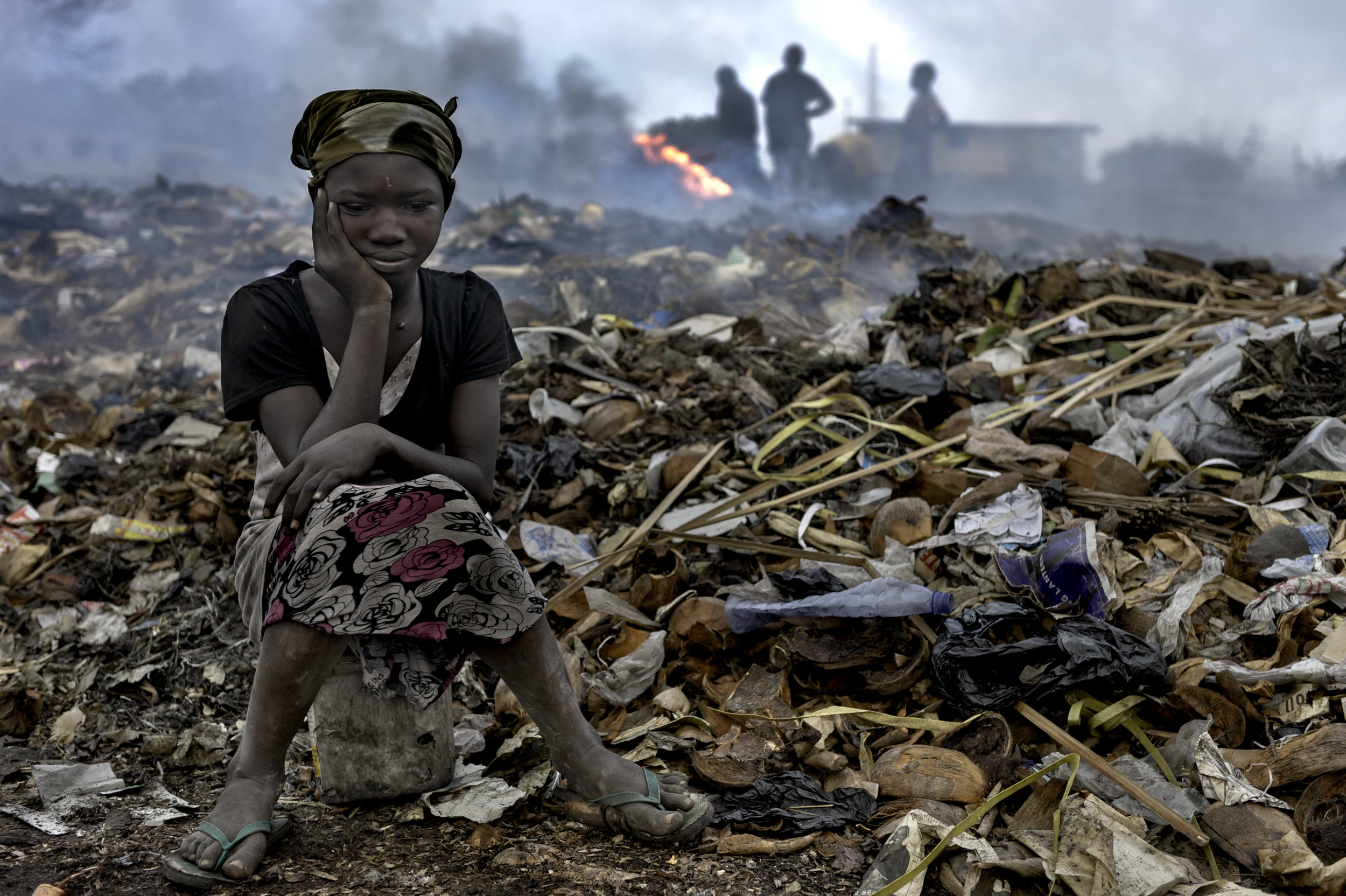
Few Options for the Impoverished
Ayisha, 10, rests on her small bucket of metals that she scavenged at a burn site for e-waste. She will weigh and recycle the metals for money. Along with other children, she works at breaking down and extracting the precious metals from old computers with their bare hands and magnets. There are no environmental regulations as no one is wearing a mask or protective clothing at the site. Much of these waste materials are burned, exposing the children to toxic fumes. Ayisha lives in Old Fatima, a suburb of Accra, Ghana, with a group of children who have no parents and no education. They are impoverished children that have been left here with few options in life.

Electronic Waste Workers
Older boys, such as Mohamed Abukari, 17 (framed center), usually are first to burn and pick through the residue of discarded computers for copper wiring or any other valuable metals. In the background, other boys are getting ready to ignite more items into flames. These boys make the most money at this electronic waste site while younger children, who go through what’s left, make almost nothing in Accra, Ghana.
Photograph © Renée C. Byer

Prison of Poison
Philimon, 14, is homeless and works in this polluted world for it is all he has in life. His eyelashes are singed and skin is blackened from burning electronic waste discarded from the Western world in Ghana, West Africa.
Photograph © Renée C. Byer

Homeless in Accra
Marjyama, 27, the mother of 2-year-old twin girls, has been homeless living under a "Do Not Urinate Here," sign she made in the city of Accra, Ghana, in West Africa. She came to the city seeking work but now hopes to someday return to her home in a farming village in the north and once again be near family. Many girls leave their families hoping to find opportunity for a better life in the city but become exploited, pregnant and unable to return home or care for their children.

Child Herders
Seeking Shelter from the Rain
Known as "Little Cowboys," in their Ghanaian village Tibetob Gmafu, 5, left, Bidimei Gmafu, 5, center, Dawuni Bisun, 7, upper right, and Ninankor Gmafu, 6, below, seek cover from the rain as they keep a watchful eye on cows they were herding. The children say they are not allowed to bring the cows home in bad weather for fear that they will be beaten. They live in fear of a snakebite after their father was blinded by a snake and a brother died. They say they have beaten to death three snakes this past year. They all wish they could go to school instead of working every day herding the animals in their village in the Volta region of northern Ghana.
Photograph © Renée C. Byer

Fear of Snakes
Dawuni Bisun, 7, is partially blurred in motion as he chases a stray cow at full speed in tall grasses in the African bush. He must work minding cows despite his fear of snakes and despite the fact that he works without any protective clothing as he runs about the bush chasing cows in Northern Ghana.
Photograph © Renée C. Byer
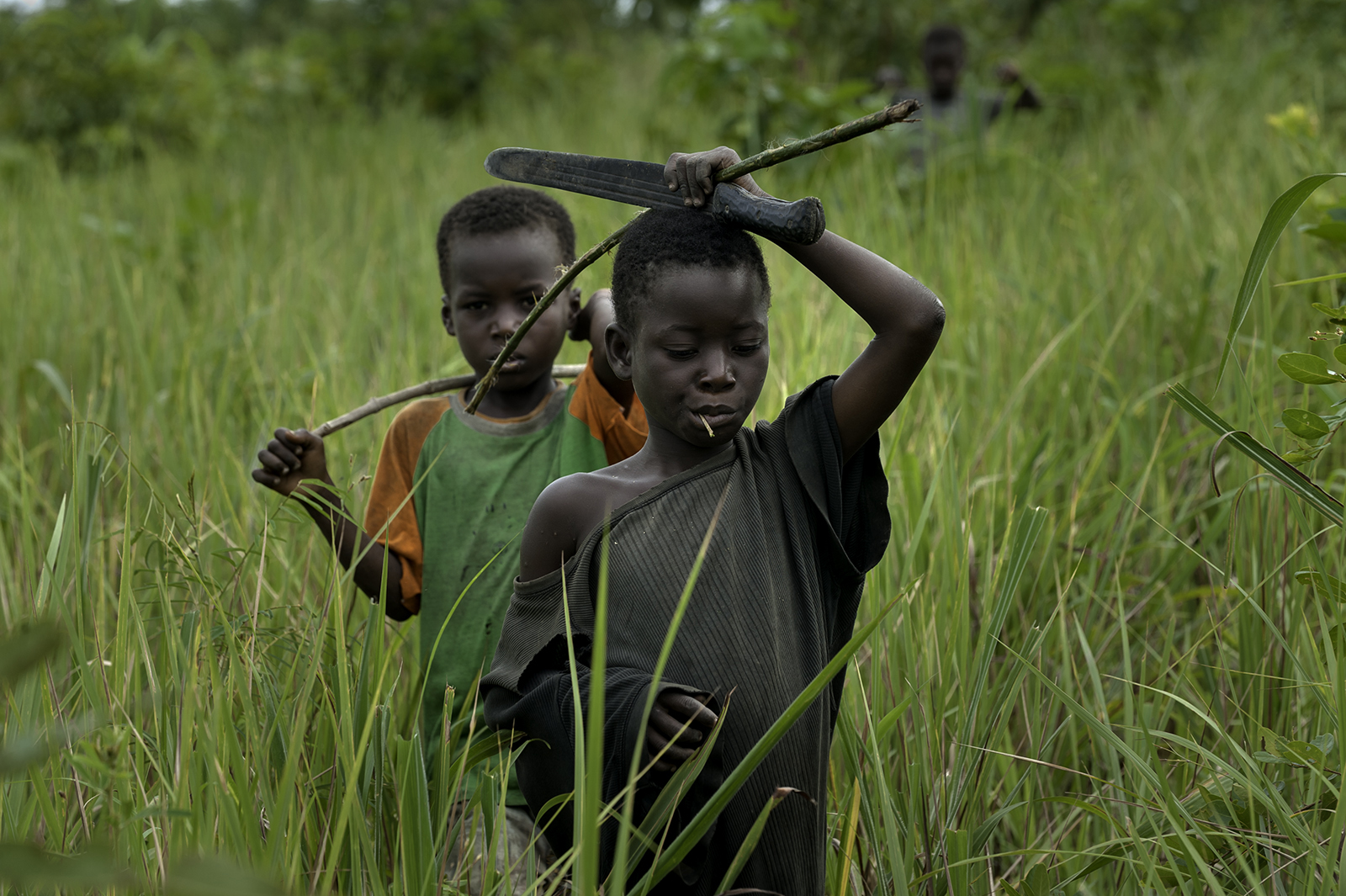
Tall Grasses
The boys of the Gamfu family Ninankor Gmafu, 6, and Tibetob Gmafu, 5, carry their machetes as they go off to their day’s work of caring for some forty cows that roam about the property that they are required to watch over in northern Ghana.
Photograph © Renée C. Byer

Horseplay
Taking a few moments to wrestle as they horseplay are Dawuni Bisun, 7, and his brother Tibetob Gmafu, 5, as Ninankor Gmafu, 6, watches over the herd in the background in the Volta Region of Ghana.
Photograph © Renée C. Byer

Dreams
At the end of the day, Dawuni Bisun, 7, uses all his weight as he works to tie up the cows for the night with a rope their father weaved for them, in the Volta region of Ghana. "I would prefer to go to school. If you are a student you can learn much about things and expand your brain," said Dawuni. He said he dreams of being a President like Nelson Mandela.
Photograph © Renée C. Byer

Sitting for Hours
In the forefront, Ester Cooper, 14, sits on a bucket due to leakage of urine as she awaits her second fistula repair after her first failed. She lost her child during birth, and her family has cast her aside. Behind her is Kpana Suno, 21, awaiting her third operation in the hope that this repair will work and she will be able to return to school. The girls can sit on buckets from six to eight hours at a time in the hospital and all lack sleep because of this condition.

Liberia Rape Victim
Barbara Alfred, 15, lives in an orphanage in Monrovia, Liberia. She was raped by two of her uncles and left with a fistula that makes her unable to control her urine. She has been isolated from others at the orphanage and has been forced to sleep on only metal springs.
Photograph © Renée C. Byer
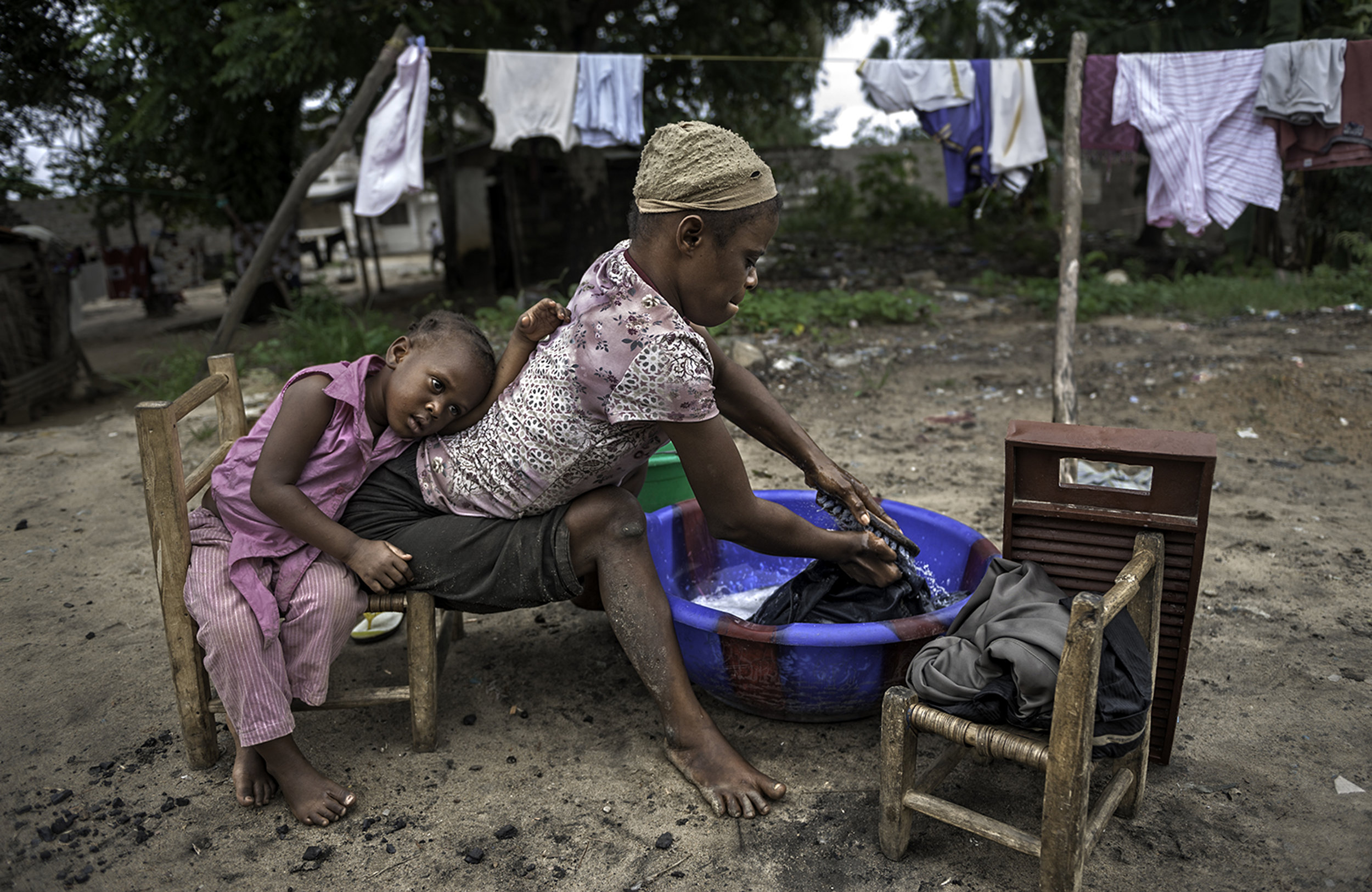
Disabled but Still Working
Jestina Koko, 25, with her daughter Satta Quaye, 5. Crippled since the age of three, she depends on her arms to lift and drag herself. She survives by doing laundry for others, selling cookies on the street, and begging in Monrovia, Liberia. Both of them suffer from malaria. She wishes for a wheel chair, a private room to live in and for her daughter to go to school. They sleep in the hallway of a home that has no electric, toilet or running water and own nothing.
Photograph © Renée C. Byer
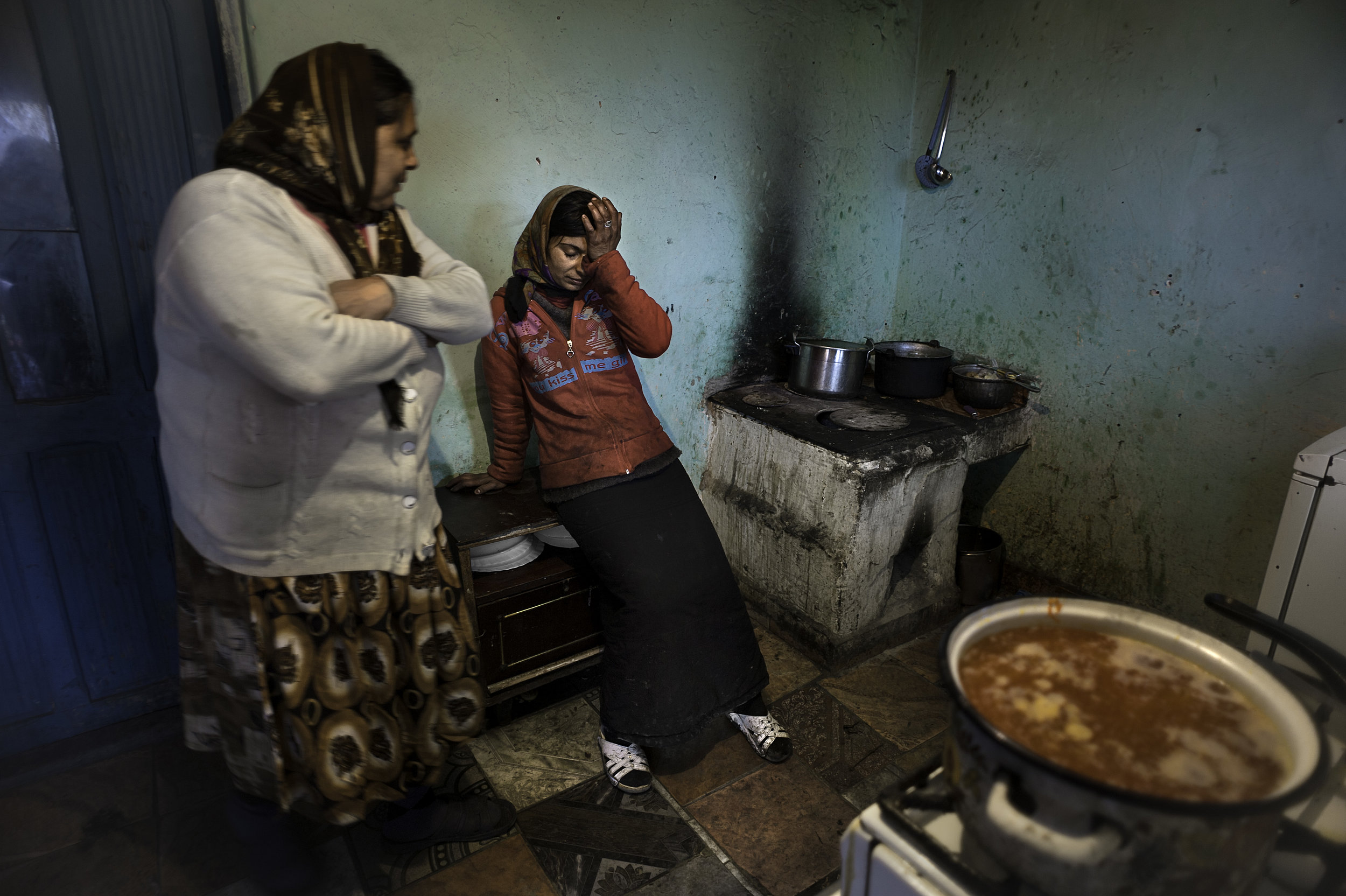
Living in Pain
Complaining of stomach pains Viorica Gulie, 31, takes a break from cooking soup for her family as her mother-in-law Constanta Gulie, 58, looks on at left. She suffers from gastritis of her stomach. With no money for medication or to go to the hospital she has to live in pain. Their house, which has no running water or a bathroom, is built on state land and they don't have title deeds so they are in fear of being evicted in Slatina, Romania.
Photograph © Renée C. Byer
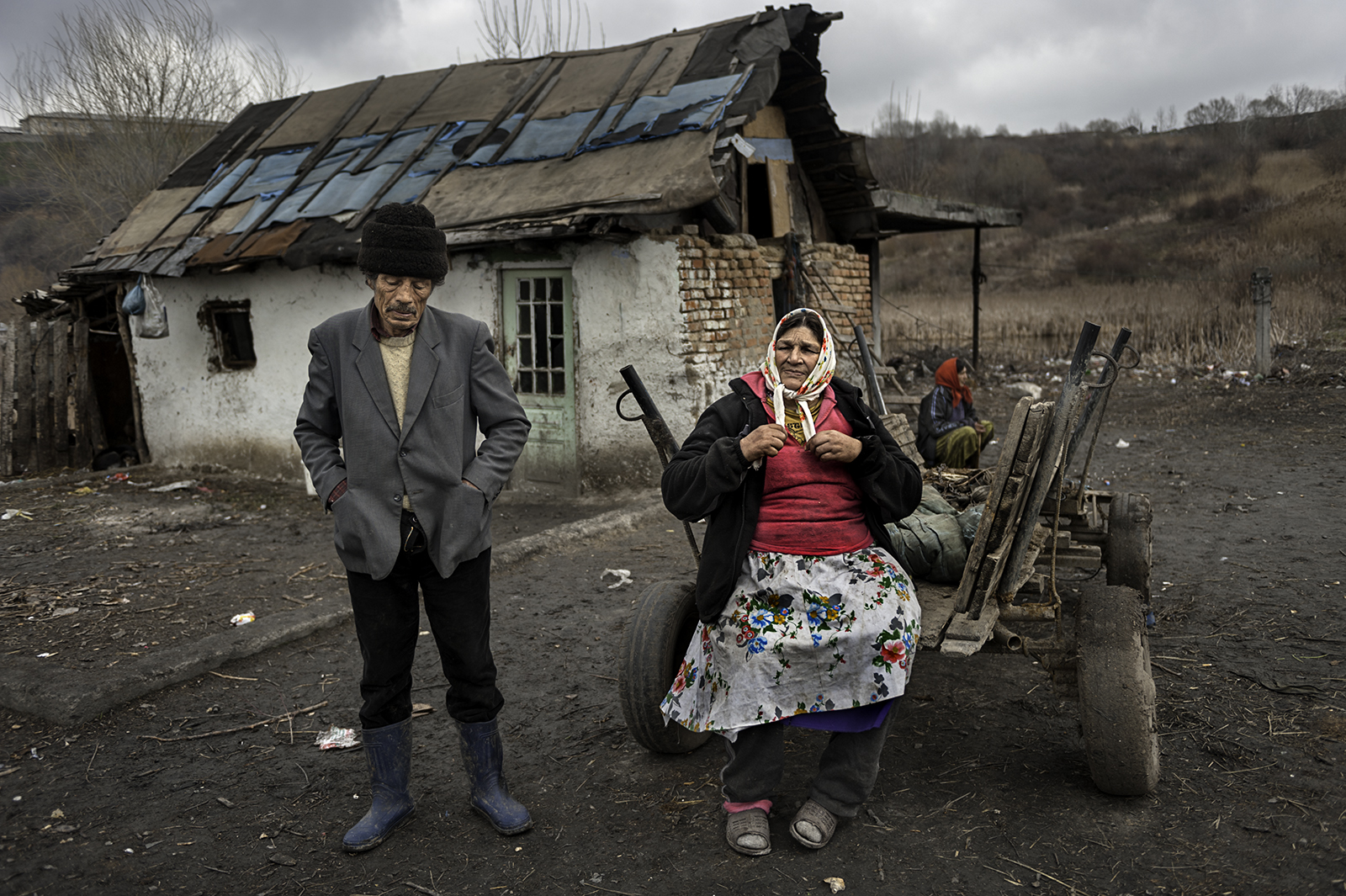
Gypsy Community
Virgil Leanta, 60, lives in fear of eviction with his wife Stela Paun, 60, in a house that they don’t own in Slatina, Romania. Her husband has no government identification so he can’t get any financial help. Stela suffers from diabetes and gets free medicine from the hospital every month. She receives financial help from the government in the amount of 120 Romanian Lei, equivalent to $28. They survive eating snails they catch in the pond behind the house and eggs from their three chickens. Without electricity they use candles to illuminate inside the house. The recent loss of their horse they used to pull their cart has been a hardship.

Peering Out
In Bucharest, Romania, the Opiteanu family wrapped plastic tarps around heating pipes to make a home in a park located in a wealthy area. It keeps them warm in the cold winters. Their 15-month-old, Robert Opiteanu, peers out of a clear panel in the early morning looking for his mother. She left before sunrise to buy flowers at market to repackage and sell at the train station. His father works carrying groceries for wealthy people. The squatters hope not to be evicted from their makeshift home.

Hoping for a Miracle
Four-year-old Ana-Maria Tudor, above, stands in the light of her doorway in Bucharest, Romania, hoping for a miracle as her family faces eviction from the only home they have ever had. Her father recently had a gall bladder surgery that resulted in an infection and left him unable to work. The one room they live in has no bathroom or running water.
Photograph © Renée C. Byer

Romania's Lost Generation
In Bucharest, Romania, some of the city's poor climb down into underground heating vents or sewers, where they live and eat by candlelight for there is no electricity. Here Hora Florin, 28, a victim of the Romanian dictator Nicolae Ceasescu's orphanages and one of Romania's lost generations of children, lives underground where the heating vents keep him warm at night.
Photograph © Renée C. Byer

Moldova’s Rural Poor
Anastasia, 4, hugs her favorite pet as her brother Ion, 15, attends to his chores around the house. She accompanies her mother in the fields to work for money and food. There is not enough money to send her to kindergarten in the rural village of Fintinita, Moldova.
Photograph © Renée C. Byer

Subsistence Living
In her home in Moldova, Viorica Bujor, 78, holds two goose eggs that will make up a significant part of her grandchildren’s dinner. For twelve years this family has lived in a house with no electricity, broken windows, and no heat.
Photograph © Renée C. Byer

Soccer Play
Brothers Jefferson Liedo Guzman, 6, center, and Ronaldino Liendo Guzman, 10, right, play soccer while passing the time for their mother to return home from work. Their makeshift home where they are squatting in the hills of Lima, Peru has no electricity, running water or a bathroom. Their mother, a victim of domestic violence sings on the street and on buses to support them. Sometimes the boys accompany her singing on buses.

Makeshift Shelter
On a hillside overlooking the city of Huaycan, Peru, sit three boys who await their mother’s return home. Their mother, a victim of domestic violence, sings on the street and in buses to try to make a living and provide for them, yet not even the 10 x 10–foot home they live in is theirs. It is a home with no bathroom, only one broken bed, and nothing but an open fire over which to cook. It is a makeshift shelter constructed illegally on this hillside from which the local authorities are trying to evict them.
Photograph © Renée C. Byer

Recycling Break
Anderson Suarez Orihuela, 4, plays peek-a-boo as he hides behind a mesh bag and peeks out at the world around him in Lima, Peru. Recycling and subsistence farming is the two biggest livelihood's of the rural poor. Many children are needed to help their mother's work and as a result like Anderson can't go to school.
Photograph © Renée C. Byer

The Cycle Continues
At bedtime domestic violence victims, Erika Orihuela Gonzales nurses her youngest child Naisha, 2, while her oldest daughter Josselin Carhuallanqui, 16, in the background, does the same for her child, Dayron, 8 months. In total, this family of six live day to day on two to four dollars per day, in addition to what Josselin might earn, if and when she can find work. Dayron suffers from asthma and Josselin had just lost her job that day. Every day Erika walks with her children in Lima, Peru pushing a baby cart as the children help her recycle. The children can’t attend school because they are needed to work.

Making a Difference
The children at La Sagrada Familia orphanage in a slum outside the city of Lima, Peru, all come running when food is awaiting them. One of the largest orphanages in the world it has 830 children. All are loved by its founder Miquel Rodriguez who exemplifies the good one man can do.
Photograph © Renée C. Byer

Child Herder in Bolivia
Following the death of his father, Alvaro Kalancha Quispe, 9, helps his family survive by herding. He opens the gate to the stone pen that holds the family's alpacas and llamas each morning so they can graze throughout the hillsides during the day. He then heads off to school, but must round them up again in the evening in the Akamani mountain range of Bolivia in an area called Caluyo, about an hour from the city of Qutapampa. In this part of the world, the highlands of Bolivia, approximately 13,000 feet above sea level, residents live in homes with no insulation, no electricity, and no beds. Their water comes from streams that run off the snow-covered mountains. Photograph © Renée C. Byer

Potato Harvest
Nora Huanca Illari, 11, tosses potatoes to her mother, Manuela Illari, 45, as they farm land in a field outside of Santiago de Okola, Bolivia. They work for some potatoes and food for their animals. Nora goes to school every morning and in the afternoon she works with her family in the fields until sunset. In the background is the mountain known as the Sleeping Dragon.
Photograph © Renée C. Byer

Generation of Farmers
Manuela Illari, 45, center, is helped by her two daughters Berta Huanca Illari, 1, and Nora Huanca Illari, 11, while working in the potato fields in exchange for food to feed her family and animals in Santiago de Okola, Bolivia. Nora goes to school in the morning and then comes to work in the fields until sunset watching her little sister and sharing the farming duties with her mother.
Photograph © Renée C. Byer
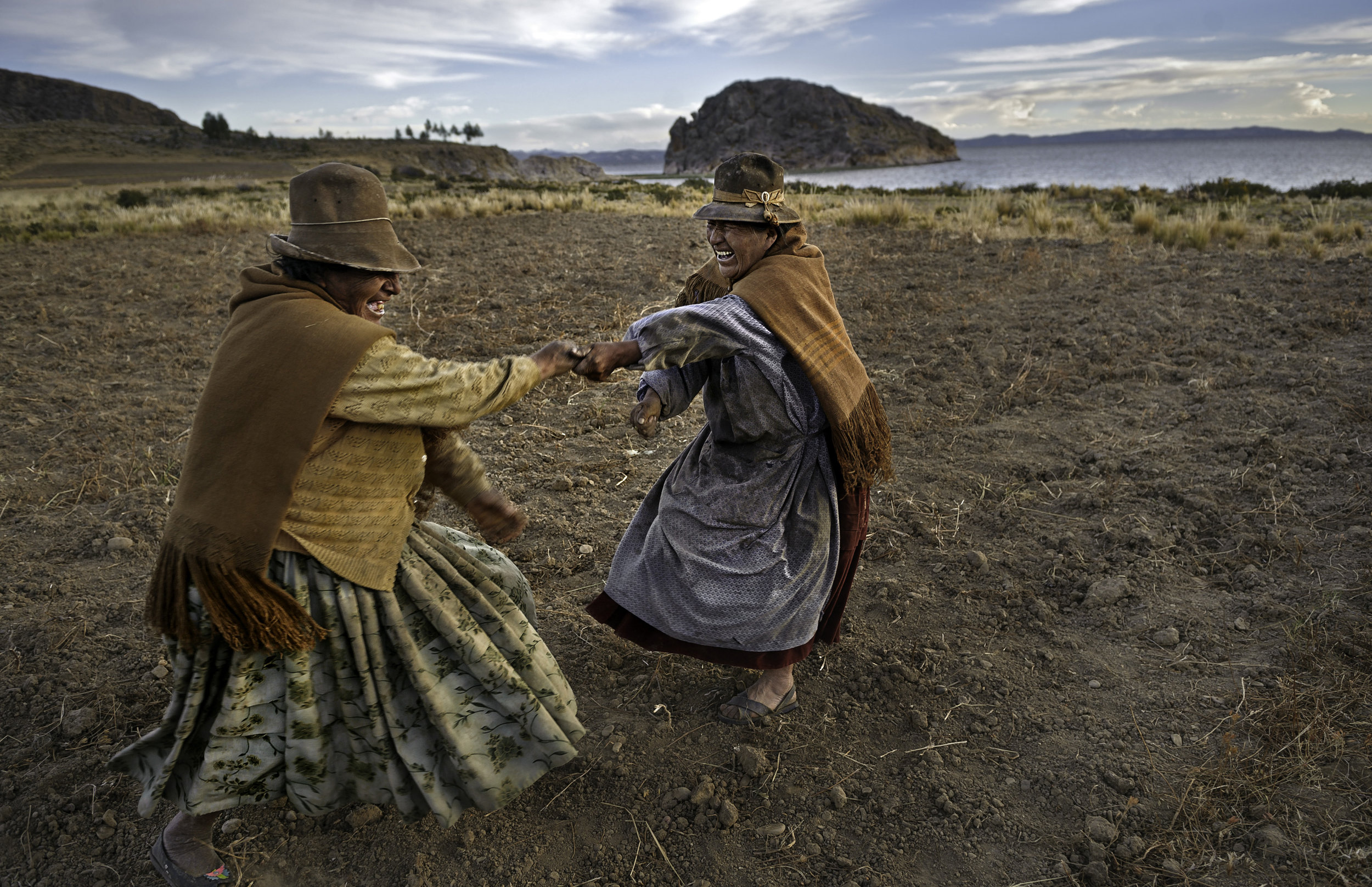
Celebration Dance
Dominga Illari, 70, left, and Manuela Quispe Avile, 70, right, dance after harvesting potatoes. Avile is the owner of the land and Illari works for her in exchange for food to eat, not money in Santiago de Okola, Bolivia.
Photograph © Renée C. Byer






















































